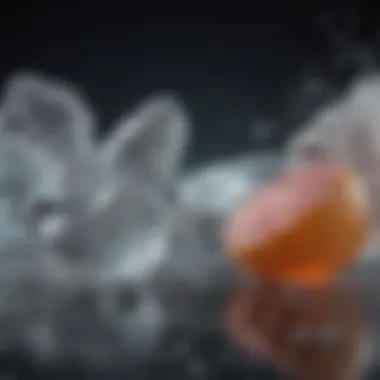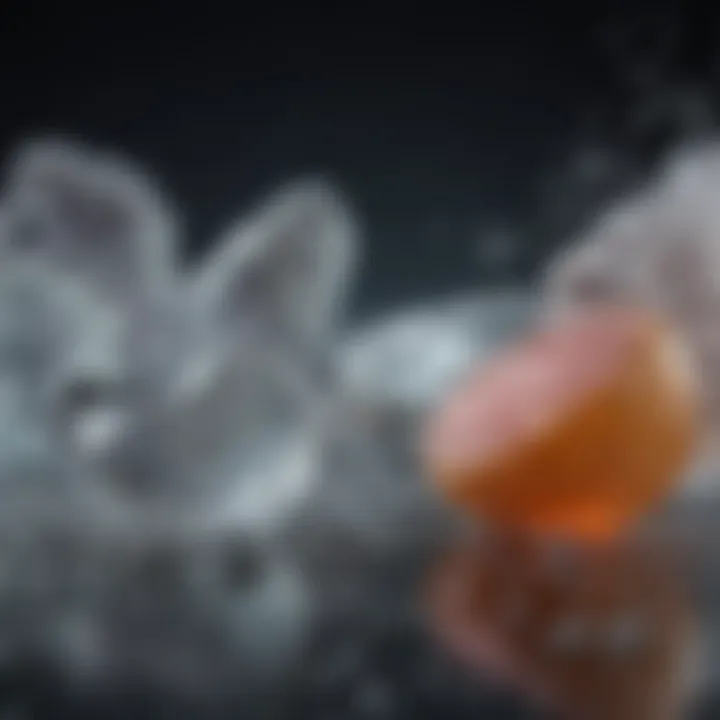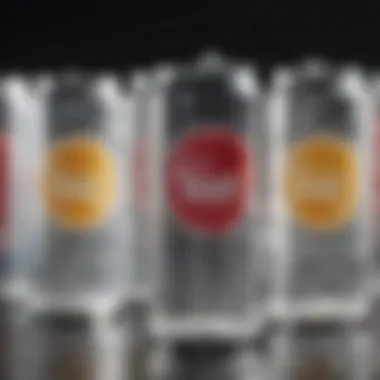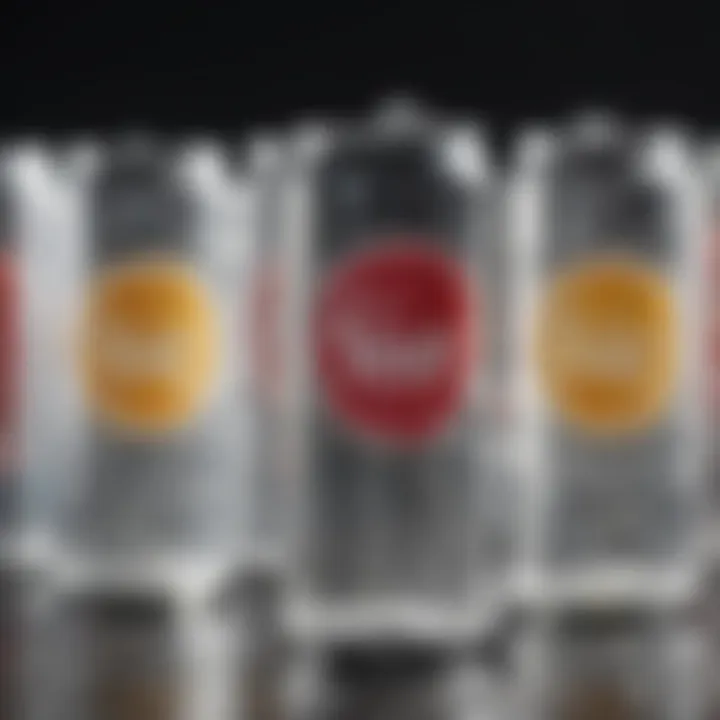Unpacking the Ingredients of Seltzer Water: A Deep Dive


Intro
Seltzer water has become a popular beverage choice for many people, especially in the context of health and wellness. Understanding what constitutes seltzer water is essential for those who wish to appreciate its unique qualities fully. This article will explore the primary components of seltzer water, looking closely at the ingredients, their impact on flavor, and their health implications.
Seltzer water is carbonation of plain water, but not all carbonated waters are the same. This guide aims to dissect the specifics of seltzer and clarify how it is different from other sparkling beverages like tonic water or club soda. In recognizing these distinctions, consumers can make informed choices that align with their palates and health considerations.
Understanding Seltzer Water
Understanding seltzer water is essential for both culinary enthusiasts and beverage consumers. The nature of this drink influences hydration, flavor, and even health. It is more than just carbonated water; its composition can greatly impact how it is perceived and enjoyed. Seltzer water serves as a versatile base in culinary applications and has gained popularity as a refreshing alternative to sugary drinks. By unpacking its elements, one can appreciate its qualities and make informed choices when enjoying or using it in recipes.
Definition and Overview
Seltzer water is a type of carbonated water that is typically free from minerals and flavors. The term often refers broadly to artificially carbonated water, but "seltzer" specifically describes water that has been carbonated through adding carbon dioxide. Unlike sparkling mineral water, seltzer lacks the naturally occurring minerals that can influence its taste. It is often enjoyed on its own or can serve as a mixer in various beverages.
The carbonation process creates bubbles that give seltzer water its distinct tingling sensation. It is worth mentioning that seltzer can be found in plain form or flavored varieties. While the flavor versions do have additives, the base remains similar—making it a favored choice among health-conscious consumers and mixologists alike.
Historical Context
The history of seltzer water is intriguing, with roots tracing back to natural springs. The word "seltzer" originates from a German spa town called Selters, known for its naturally carbonated mineral water. This water was lauded for its perceived health benefits.
In the late 18th century, inventors like Joseph Priestley began experimenting with carbonation. He discovered that infusing carbon dioxide into water created a similar sensation to that of natural springs. Following these developments, seltzer became more accessible with the advent of home carbonation systems in the early 20th century. This democratization of bubbly water led to its widespread popularity in both casual and formal settings.
Today, seltzer is found everywhere—from grocery aisles to trendy bars. The rise in health consciousness and the preference for non-sugary drinks have also contributed to its resurgence in contemporary culture. Understanding this evolution adds depth to how seltzer is viewed in the context of beverages and nutrition.
Key Ingredients in Seltzer Water
Understanding the key ingredients in seltzer water is essential for anyone interested in this popular beverage. Seltzer water, at its core, is primarily carbonated water. However, the complexities and nuances extend beyond just this basic ingredient. The presence of additional minerals and possible additives contribute not only to the flavor and texture but also to the overall health implications. For culinary enthusiasts, knowing these details enhances the experience of consumption and allows for informed pairings with food.
Carbonated Water
Carbonated water is the foundation of any seltzer drink. The carbonation process involves dissolving carbon dioxide gas under pressure into water. When released, this gas creates the characteristic bubbles that define seltzer water. The level of carbonation can vary, affecting the mouthfeel and perceived freshness of the drink. The intensity of these bubbles plays a significant role in consumer enjoyment. Extra fizzy seltzers are often more appealing for their crisp sensation, while those with less carbonation might provide a smoother drinking experience without overwhelming the palate.
Minerals and Their Sources
While seltzer water is primarily composed of carbonated water, the introduction of minerals enhances its profile. Common minerals found in seltzer include sodium, magnesium, and calcium. These minerals can come from various sources, ranging from added natural minerals to mineral-rich spring waters. Many brands actively market their mineral content as a health benefit, appealing to consumers looking for more than just hydration.
Minerals have functional roles as well. For example, magnesium contributes to flavor complexity and may provide additional health benefits, such as bone health. Having clarity on where these minerals come from not only benefits knowledgeable consumers but also supports responsible choices in beverage selection. Brands like LaCroix or Spindrift often include these minerals, enhancing their offerings while marketing toward health-conscious audiences.
Potential Additives
Additives can make a significant difference in the seltzer experience. Many manufacturers incorporate flavors, ranging from natural to artificial, to cater to diverse palates. Common flavorings include citrus, berries, and even exotic options like hibiscus or cucumber. Understanding these additives helps buyers discern between a more straightforward seltzer and one that aims at specific taste profiles.
While flavors provide versatility, it is crucial to read labels carefully. Some brands may utilize additives that could include sugars or artificial sweeteners. This can affect not only the beverage taste but also its health implications. A careful examination of the ingredient list can guide health-conscious consumers toward options that best fit their dietary preferences.
"Being aware of the composition of your beverage can significantly improve the drinking experience and align it with your health goals."
In summary, the exploration of key ingredients in seltzer water reveals layers of intricacies that go beyond mere hydration. The interplay between carbonation, minerals, and potential additives shapes the flavor and consumer experience, highlighting the importance of informed choices when enjoying seltzer.


Carbonation Process
The carbonation process is a crucial aspect of seltzer water that affects its flavor, texture, and overall drinking experience. Understanding how this process works is essential for anyone who enjoys seltzer water or is interested in its culinary uses. Different carbonation methods can influence the sensory qualities and health perceptions tied to seltzer water.
Natural vs. Artificial Carbonation
Natural carbonation occurs when water comes into contact with volcanic gases or other sources of carbon dioxide underground. This method is often favored in premium sparkling waters because it brings a unique profile to the beverage. Each source has distinct mineral content, which also affects taste. However, natural carbonation is less common in commercially available seltzers, making it a more exclusive option.
On the other hand, artificial carbonation is the process where carbon dioxide is added to still water under pressure. This method is widely used due to its consistency and scalability. While this method may lack the uniqueness of natural carbonation, it is effective for mass production. Both methods provide a refreshing experience but cater to different markets and preferences.
Methods of Carbonation
The methods of carbonation can vary greatly and include several techniques:
- Carbonation with CO2 Cylinders: This is the most common method for commercial beverages. Gas cylinders release carbon dioxide into the water at controlled rates. The dissolved CO2 creates bubbles and increases the drink's crispness.
- Carbonation Stones: These are porous stones used in brewing to introduce CO2 into liquids. The fine bubbles that form help achieve a very consistent level of carbonation.
- Force Carbonation: In this method, carbon dioxide gas is rapidly infused into cold water. The cold temperature helps trap CO2 in the liquid, ensuring an effervescent quality.
Each of these methods has its advantages and can be seen in different brands and products available in the market.
Impact on Beverage Quality
The carbonation process significantly impacts the overall quality of seltzer water. Higher levels of carbonation can enhance flavor perception, making the drink feel crisper and more refreshing. However, too much carbonation can lead to an overwhelming sensation in the mouth, which some consumers might find unappealing.
Moreover, the quality of carbonation affects the longevity of bubbles. Any beverage with well-maintained carbonation will keep its effervescent quality longer, ensuring an enjoyable experience from the first sip to the last.
"The sensation of carbonation plays a pivotal role in how we experience seltzer, influencing not just taste but mouthfeel and refreshment."
Comparison with Other Sparkling Beverages
Comparing seltzer water with other sparkling beverages is essential to understand its unique characteristics and nutritional elements. This section explores how seltzer stands apart from club soda, tonic water, and sparkling mineral water. Each beverage offers distinct flavor profiles, uses, and health considerations. Knowledge about these differences can aid consumers in making informed choices about their hydration.
Club Soda
Club soda is often mistaken for seltzer, but it has distinct differences. While seltzer consists purely of carbonated water, club soda contains added minerals like sodium bicarbonate or potassium sulfate, which enhance flavor. This mineral content gives club soda a slightly salty taste. Many people use club soda as a mixer for cocktails because the minerals can alter the drink's taste profile.
Additionally, the added minerals can affect the body's hydration. The sodium in club soda, for instance, may not be suitable for individuals on low-sodium diets. Therefore, understanding these nuances is crucial for those keen on monitoring their dietary requirements while enjoying sparkling beverages.
"Club soda may satisfy a need for flavor without the need for sugars or sweeteners, but it is not the same as seltzer, which remains purely hydrating."
Tonic Water
Tonic water is another beverage that often gets confused with seltzer. Unlike seltzer and club soda, tonic water contains quinine, which gives it a distinctive bitter taste. Many brands also add sugar or artificial sweeteners, enhancing the flavor but increasing calorie content. Thus, tonic water might not be the best option for those watching their calorie intake.
The addition of quinine also has medicinal properties. Historically, quinine was used to prevent and treat malaria, but the quantities present in tonic water today are quite low. Consequently, while it offers some unique attributes, tonic water cannot be considered a health beverage in the same vein as seltzer or sparkling mineral water. Seltzer remains a calorie-free option, making it more suitable for everyday consumption.
Sparkling Mineral Water
Sparkling mineral water often contains naturally occurring minerals from the source's spring. This beverage provides essential minerals like calcium, magnesium, and bicarbonates, contributing to a more complex flavor profile. Many individuals prefer sparkling mineral water for its perceived health benefits, stemming from these minerals.


Choosing seltzer over sparkling mineral water might come down to personal preference in taste and dietary needs. Sparkling mineral water can offer additional health benefits due to its mineral content, but it may also carry higher sodium levels, depending on the source. Those who are more health-conscious should scrutinize labels carefully to determine which beverage aligns with their dietary needs.
In summary, understanding the differences between seltzer water and other sparkling options can provide clarity. Club soda, tonic water, and sparkling mineral water each hold unique qualities and implications for flavor and health. This knowledge empowers consumers to select the appropriate beverage for their specific tastes and health concerns.
Health Considerations
Understanding health considerations related to seltzer water is crucial for consumers who are mindful of their hydration and overall well-being. Seltzer water may appear simple, but its effects on health and hydration merit thorough examination. Here, we will delve into the hydration benefits, the implications of carbonation, and dietary considerations connected to seltzer water consumption.
Hydration and Benefits
Seltzer water primarily consists of carbonated water, which plays an essential role in hydration. Staying adequately hydrated is important for maintaining optimal physiological functions, such as regulating body temperature, maintaining joint health, and supporting digestive processes. Many people enjoy seltzer water as a refreshing alternative to sugar-laden soft drinks or flavored beverages.
Moreover, drinking seltzer water can encourage higher fluid intake, especially among those who might not favor still water. The carbonation can enhance the palate, making hydration more enjoyable. Additionally, the presence of certain minerals can offer supplementary benefits. For instance, magnesium and calcium found in some seltzer waters can help in muscle function and bone health, respectively.
Effects of Carbonation
The carbonation process influences both texture and sensation. When seltzer water is consumed, the bubbles stimulate taste receptors, enhancing the overall drinking experience. While carbonation is often associated with bloating or discomfort in some, the concentration of carbon dioxide levels in seltzer water is relatively low compared to other beverages like tonic water or soda.
It is worth noting that some research suggests that carbonated beverages could contribute to increases in satiety. This could lead to reduced calorie intake during meals. However, individual responses to carbonation can vary significantly. Thus, some individuals may experience gastric upset, particularly if consumed in excess.
Dietary Implications
Incorporating seltzer water into a balanced diet can be beneficial, but it is essential to consider overall nutrition. For those monitoring sodium intake, not all seltzers are created equal. Some brands may contain added electrolytes or minerals that increase sodium levels. Therefore, consumers must read labels carefully.
Furthermore, flavored seltzers with added sugars or artificial sweeteners should also be assessed in the context of dietary needs. While many prefer a sparkling option for taste, it's best to avoid excessive sugar intake prevalent in some flavored variants. Overall, seltzer water can complement a healthy diet, as long as choices align with personal health goals and preferences.
In summary, seltzer water offers hydration benefits while providing a refreshing alternative to regular beverages. It's essential to be conscious of individual sip preferences and to assess ingredients in flavored varieties for maintaining healthful choices.
Flavor Profiles of Seltzer Water
Understanding the flavor profiles of seltzer water is essential for several reasons. First, consumers often seek specific taste experiences that match their preferences and dietary needs. Second, flavors can enhance the overall drinking experience, influencing customer choices and market trends. Third, the interplay of ingredients, especially the mineral content and any added flavorings, can significantly impact how a beverage is perceived, both in taste and health implications.
Fragrance Variants
Seltzer water can come in various fragrance variants, which can elevate its appeal. Often, manufacturers create flavored seltzers using natural essences or extracts from fruits, herbs, or spices. Common variants include lemon, lime, berry, and more exotic flavors like hibiscus or ginger. These aromas are not just for aesthetic purposes; they can influence the drinker's perception of taste.
Flavoring seltzer water tends to increase its marketability among diverse demographics. This is especially true for those who may find plain carbonated water less enjoyable. The inclusion of naturally derived flavors can provide a refreshing twist without the calories or sugars found in soft drinks. However, it is important to note that consumers should check for additives. Some brands might use artificial flavorings or sweeteners, which can alter the health benefits of the product.
Influence of Mineral Content
Mineral content plays a notable role in the flavor profile of seltzer water. The presence of minerals such as magnesium, calcium, and sodium can create a distinct mouthfeel and taste experience. Seltzers with higher mineral content often have a slightly salty or mineral-like taste, which some consumers may prefer. This uniqueness can set certain brands apart from others in a saturated market.
Moreover, the source of water contributes to these flavor nuances. For instance, water from certain springs may carry specific mineral compositions that naturally enhance the beverage flavor. This aspect is sometimes touted by brands as a selling point, reinforcing the idea that not all seltzer waters are created equal. Consumers who appreciate the tasting notes will likely gravitate towards products that highlight their mineral profiles.
Consumer Preferences
Consumer preferences regarding seltzer water are substantial and varied. Many individuals choose sparkling water for its refreshing qualities and lower calorie content compared to sugary drinks. Some consumers also enjoy the fizziness that carbonation provides. Preferences can shift due to health trends or personal taste changes.


Surveys indicate that a significant segment of the population seeks variety in their beverage choices. As a result, brands have adapted by offering an extensive range of flavors and styles, catering to a market that values both novelty and reassurance in the quality of ingredients. Insights into consumer behaviors also suggest that customers may prioritize brands that are transparent about their ingredient sourcing, especially regarding mineral content and flavoring.
Environmental Impact
The environmental consequences of seltzer water production merit critical examination. As consumers increasingly seek refreshing beverages, understanding these impacts is essential for informed choices. The production and distribution of seltzer water involve various elements that can either contribute positively or detrimentally to the environment. This section will discuss the significance of packaging concerns and sustainability practices central to seltzer water.
Packaging Concerns
Packaging plays a pivotal role in the environmental footprint of seltzer water. Many brands utilize plastic bottles, which contribute to the global plastic crisis. The production process for plastic is energy-intensive and creates pollution. Furthermore, many plastic bottles are not recycled, leading to increased waste in landfills and oceans.
On the other hand, aluminum cans are commonly used for seltzer water packaging. They have a lower ecological impact as they are 100% recyclable and can be reprocessed nearly indefinitely without quality loss. This drastically reduces the need for new raw materials and energy consumption compared to single-use plastics. Consumers should consider the type of packaging when selecting their preferred seltzer water.
"The choice of packaging reflects not only on product quality but also on environmental responsibility."
Sustainability Practices
Sustainability practices in seltzer water production significantly affect environmental outcomes. Brands are increasingly adopting eco-friendly approaches in response to consumer demand. Some methods include using renewable energy in production facilities, which lowers carbon emissions.
Another practice is sourcing water from sustainable aquifers. This procedure ensures that natural water supplies remain protected while meeting demand. Additionally, companies are exploring ways to minimize the carbon footprint of transportation by optimizing delivery routes or using energy-efficient vehicles.
Furthermore, some brands focus on less carbon-intensive carbonation processes. This innovation can contribute to reducing greenhouse gas emissions involved in their products' lifecycle.
Seltzer Water in the Culinary World
Seltzer water holds a unique position in the culinary landscape. It is not just a refreshing beverage, but also a versatile component that enhances various dishes and experiences. In this section, we will explore how seltzer water is utilized in culinary applications and how it pairs with different foods.
Use in Culinary Applications
The incorporation of seltzer water in cooking and drink making is gaining popularity. Its carbonation can add a distinctive fizz to beverages and dishes, elevating them in both texture and taste. Here are several applications where seltzer water shines:
- Cocktails and Mocktails: Seltzer is often used as a mixer in cocktails, providing a light and refreshing base. Its effervescence can enhance the flavors of spirits and juices. In non-alcoholic drinks, seltzer water serves to create vibrant mocktails that appeal to both adults and children.
- Cooking Techniques: In culinary techniques such as batter making, seltzer can be employed to create lighter, fluffier textures. For example, adding seltzer water to pancake or tempura batter yields a crisp, airy result that is hard to achieve with regular water.
- Marinades and Sauces: Incorporating seltzer into marinades can help tenderize proteins. It acts as a natural ingredient, infusing flavors while maintaining a subtle balance. This method is particularly effective for chicken or fish, allowing the dish to retain moisture and zing.
"Seltzer water not only refreshes but also transforms how food is prepared and enjoyed."
Pairing with Foods
The interplay between seltzer water and food is as much about texture as it is about flavor. Its neutral taste offers a wonderful backdrop that complements a diverse range of dishes. Here are some effective pairings to consider:
- Seafood: The lightness of seltzer pairs well with seafood. Whether it’s grilled shrimp or a delicate fish dish, seltzer can enhance the natural flavors without overpowering them.
- Salads: Adding seltzer as a dressing base or a component in vinaigrettes adds liveliness to salads. It can amplify the freshness of ingredients like leafy greens, tomatoes, and cucumbers.
- Spicy Foods: If you enjoy spicy cuisine, seltzer can help balance the heat. It provides a refreshing contrast to dishes full of bold flavors, such as spicy curries or tacos.
- Desserts: Seltzer can be used in some dessert recipes, particularly in gelatins or fruit salads. It can offer a bubbly twist that adds excitement to sweet courses.
Epilogue
In the exploration of seltzer water, a few crucial elements stand out. First, the ingredient composition plays a significant role in defining not only the taste but also the health benefits of the beverage. Understanding the balance of carbonated water and minerals addresses why some seltzers feel refreshing while others may have a distinct taste depending on their source. Additionally, the carbonation process—whether natural or artificial—adds another layer of complexity to the flavor profile.
The culinary versatility of seltzer water is another essential consideration. It integrates into cooking in unique ways, either as an ingredient in recipes or as a pairing with various dishes. Additionally, its low calorie count appeals to health-conscious consumers, making it an attractive alternative to sugary soft drinks.
Overall, this examination of seltzer water highlights the nuanced aspects that make it a beloved choice among discerning drinkers. By focusing on these specific elements and their implications, one can admire not only the beverage itself but also the thoughtfulness behind its production and consumption. The connection between ingredients and their effects on flavor, health, and culinary application demonstrates that there is much more to seltzer water than meets the eye.
Final Thoughts on Seltzer Water
Seltzer water remains an interesting topic for both casual drinkers and culinary enthusiasts. The combination of carbonation and minerals creates an intricate experience that is often underestimated. For food lovers, recognizing the varieties in flavor and texture adds value to the overall dining experience.
While considering seltzer water, it is crucial to appreciate its adaptability, health benefits, and the environmental effects of packaging and production. The future of seltzer water will likely evolve, incorporating new flavors and sustainability practices as consumer preferences shift.
In summary, as one navigates the world of seltzer water, understanding its ingredients reveals the beverage’s true potential. Whether enjoyed on its own or as part of a meal, seltzer water facilitates a refreshing encounter that extends beyond simple hydration.















